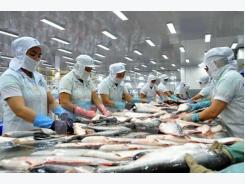Vietnam targets US$10 billion in shrimp exports by 2025

The Ministry of Agriculture and Rural Development is outlining a plan to develop Vietnam’s shrimp industry towards an export revenue of US$10 billion by 2025.
Shrimp remains the biggest hard currency earner, accounting for 44% of Vietnam's total seafood export values in 2016. (Photo: Nguyen Hue)
Vietnam has become the world’s third largest shrimp exporter after China and Indonesia. Vietnamese shrimp is available in 100 countries and territories. Vietnam is the biggest shrimp supplier to Japan, the third biggest to the US, and the fourth biggest to the EU.
Truong Dinh Hoe, Secretary General of the Vietnamese Association of Seafood Exporters and Processors, said Vietnam has an advantage over Thailand, India, and Indonesia with respect to white leg shrimp and giant tiger prawn exports.
“In the past shrimp prices were high because we depended totally on fishing. Now that white leg shrimp and lobsters are cultured, prices have dropped. This has boosted the supply, consumption, and profitability of Vietnamese shrimp products”, Hoe explains.
According to Nhu Van Can, Director of the Aquaculture Department of the Directorate of Fisheries, in the first quarter of this year, the aquaculture sector submitted an action plan for the shrimp industry to the Ministry of Agriculture and Rural Development to gather expert opinions before sending it to the government. According to Can, the Ministry will add lobsters and green clawed crayfish to the list of export items.
“The sector’s development will focus on boosting the production output of its farming areas, which cover about 600,000 to 700,000 hectares”, Can added.
Deputy Minister of Agriculture and Rural Development Vu Van Tam said to earn US$10 billion from shrimp exports by 2025, the sector needs scientific and technological breakthroughs, in breeding, production, and disease control. It also needs to expand export markets and respond appropriately to protectionism such as technical barriers. In 2017, the aquaculture sector will energetically carry out the action plan for the shrimp industry, Tam said.
“Scientific and technological breakthroughs will increase productivity. The current shrimp farming area of 140,000 hectares can be expanded in a short time. The current average productivity of 4 tons per hectare can be raised to 6 to 8 tons per hectare for leg shrimp and brackish shrimp that are cultured on an industrial scale. We need to create policies to attract new businesses, gather small producers into cooperatives and connect them with enterprises, and apply science, technology, and new models to production and export”, Deputy Minister Tam elaborates.
In recent years, due to climate change effects like large-scale saline intrusion, shrimp farming has been boosted to increase export revenues. Prime Minister Nguyen Xuan Phuc has said that in order to reach Vietnam’s target of US$10 billion by 2025, shrimp must become a spearhead export.
Có thể bạn quan tâm
Phần mềm

Phối trộn thức ăn chăn nuôi

Pha dung dịch thủy canh

Định mức cho tôm ăn

Phối trộn phân bón NPK

Xác định tỷ lệ tôm sống

Chuyển đổi đơn vị phân bón

Xác định công suất sục khí

Chuyển đổi đơn vị tôm

Tính diện tích nhà kính

Tính thể tích ao hồ



 New safety appraisal costs burden fisheries
New safety appraisal costs burden fisheries  Solutions sought for $10b shrimp plan
Solutions sought for $10b shrimp plan